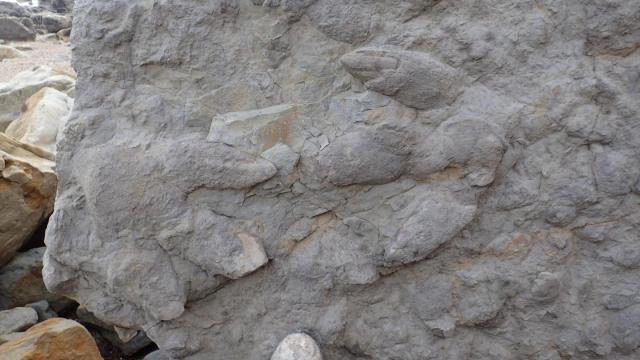A trove well-preserved dinosaur footprints has been uncovered on a beach in southern England. Dating back to the Cretaceous Period, the prints still show traces of skin, scales, and claws.
Paleontologists from the University of Cambridge have uncovered 85 dinosaur footprints from at least seven different species on a beach in East Sussex near Hastings, England. It’s now considered “the most diverse and detailed collection of these trace fossils from the Cretaceous Period found in the UK to date,” according to a statement.
The prints range in size from around a three-quarters of an inch (2 cm) to nearly 24 inches (60 cm) across. The researchers, led by Anthony Shillito, a PhD student in Cambridge’s Department of Earth Sciences, were able to identify some of the dinosaurs responsible for the prints, including an Iguanodon, an Ankylosaurus, a species of stegosaurus, and some unidentified sauropods (long necked, four-legged herbivores). The level of detail in some of these prints is truly remarkable.
The discovery of these footprints was made possible thanks to coastal erosion. Over the past four winters, strong storms and storm surges have pounded the coast, causing the sandstone and mudstone cliffs within which these prints were embedded to collapse, exposing them.
The stratigraphic layers date back to the Lower Cretaceous Period, between 145 million and 100 million years ago. Details of this extraordinary finding were published this week in the science journal Palaeogeography, Palaeoclimatology, Palaeoecology.
This region of southern England is known for producing dinosaur fossils, including the first example of fossilized brain tissue found in 2016. During the past century, however, the area has only yielded the odd dino footprint, and certainly nothing on this scale.
Dinosaur footprints are of huge value to scientists, offering insights that body fossils cannot, such as evidence of soft tissue, behaviour, and a sense of which animals and plants were living at the same place at the same time.
The area in which these particular dinosaurs roamed was likely near a water source, according to the scientists. The site also contained traces of fossilized plants and invertebrates.
“To preserve footprints, you need the right type of environment,” said study co-author Neil Davies in a statement. “The ground needs to be ‘sticky’ enough so that the footprint leaves a mark, but not so wet that it gets washed away. You need that balance in order to capture and preserve them.”
To which Shillito added: “As well as the large abundance and diversity of these prints, we also see absolutely incredible detail. You can clearly see the texture of the skin and scales, as well as four-toed claw marks, which are extremely rare. You can get some idea about which dinosaurs made them from the shape of the footprints—comparing them with what we know about dinosaur feet from other fossils lets you identify the important similarities. When you also look at footprints from other locations you can start to piece together which species were the key players.”
The Cambridge paleontologists are trying to figure out if these dinosaurs might have altered the flows of rivers. Today, large mammals, like hippos and cows, create small channels that are known to divert a river’s flow. Dinosaurs, with their tremendous size, may have caused similar processes.
Scientists have struggled to find evidence of this in the dino era, but these newly discovered footprints show hints of this process at work, such as deep footprints where thickets of plants were growing, and prints along the banks of river channels. But more research will be needed for this to be offered as evidence of dinosaurs diverting water channels.
This may be the end of paleontological explorations along this particular outcrop. Erosion has been so bad along this beach in East Sussex that officials have constructed sea defences to slow or prevent the processes of coastal erosion. As a consequence, more clues left behind by ancient creatures will remain hidden in the rocks—at least for now.
